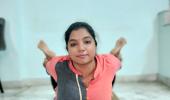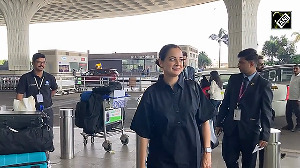rediffGURU Sabrina Merchant, founder of Li'l Yogis and a kids yoga expert, lists five exercises that will help your children focus better.
- You can post your questions for rediffGURU Sabrina Merchant HERE.
As kids grow, they face various challenges that can impact their concentration and focus.
Yoga is an excellent way to help them develop mindfulness and enhance their ability to concentrate.
Here are five yoga asanas that can help improve concentration in kids, along with tips that will help restless children.
1. Seated Forward Bend (Paschimottanasana)

Benefits: This asana stretches the spine and hamstrings, promoting relaxation and relieving stress, which aids concentration.
How to do it
- Sit with your legs extended straight in front.
- Inhale and lengthen the spine, raising your arms overhead.
- Exhale and bend forward from the hips, reaching for your toes.
- Hold the pose, focusing on your breathing and the stretch.
Tip for restless kids: Encourage them to bend as far as comfortable without straining and to focus on their breath.
2. Tree Pose (Vrksasana)

Benefits: The tree pose helps improve balance and stability, fostering a sense of focus and concentration.
How to do it
- Stand straight with your feet together.
- Shift your weight onto your left foot and place your right foot on the inner thigh of your left leg.
- Bring your hands together in a prayer position at your chest.
- Hold the pose for as long as comfortable, then switch legs.
Tip for restless kids
Encourage them to fix their gaze at a point in front of them to help maintain balance and concentration.
3. Cobra Pose (Bhujangasana)

Benefits: This pose strengthens the arm and back and stretches the shoulder, chest and abdomen. It also increases your flexibility.
How to do it
- Lie on your stomach with your palms under your shoulders.
- Press your hands into the floor and lift your chest off the ground.
- Keep your elbows slightly bent and shoulders relaxed.
- Hold for 15 to 30 seconds, then come back to step 1.
Tips for restless kids
- Encourage them to imagine they are a snake slithering up.
- Use playful language to make the pose more engaging.
4. Child's Pose (Balasana)

Benefits: The child's pose is calming and helps reduce stress and anxiety, creating a peaceful state of mind that enhances focus.
How to do it
- Kneel on the floor with your big toes touching and your knees spread apart.
- Sit back on the heels and stretch your arms forward, lowering your forehead to the ground.
- Relax in this pose, taking deep breaths.
Tip for restless kids
Use this pose as a calming break when they feel overwhelmed or restless.
5. Easy Pose (Sukhasana)

Benefits: The easy pose strengthens and stretches the body and opens the outer thighs and hips. It also calms the mind.
How to do it
- Sit on the floor with your legs crossed.
- Keep your back straight and hands resting on your knees.
- Close your eyes and take deep breaths.
- Stay in this position for a few minutes.
Tips for restless kids
- Guide them through a simple breathing exercise, like inhaling for four counts and exhaling for four counts.
- Use a soft, soothing voice to help them relax.
Additional tips for restless kids
- Have shorter sessions: Keep yoga sessions short and engaging to match their attention span.
- Incorporate play: Use stories, songs and animal sounds to make the poses more fun.
- Create a routine: Regular practice, even for a few minutes a day, can significantly improve their concentration over time.
- Encourage mindful breathing: Teach simple breathing exercises to help them calm their minds and bodies.
- Positive reinforcement: Praise their efforts and progress to encourage a positive attitude towards yoga.
Incorporating these yoga asanas into a child's daily routine can help improve their concentration and focus, making it easier for them to tackle schoolwork and other activities.
Remember to make yoga fun and engaging so they look forward to their daily practice and enjoy the benefits of a calm and focused mind.
- You can post your questions for rediffGURU Sabrina Merchant HERE

Disclaimer: All content and media herein is written and published online for informational purposes only. It is not a substitute for professional medical advice. It should not be relied on as your only source for advice.
Please always seek the guidance of your doctor or a qualified health professional with any questions you may have regarding your health or a medical condition. Do not ever disregard the advice of a medical professional, or delay in seeking it because of something you have read herein.
If you believe you may have a medical or mental health emergency, please call your doctor, go to the nearest hospital, or call emergency services or emergency helplines immediately. If you choose to rely on any information provided herein, you do so solely at your own risk.
Opinions expressed herein cannot necessarily provide advice to fit the exact specifics of the issues of the person requesting advice.











 © 2025
© 2025